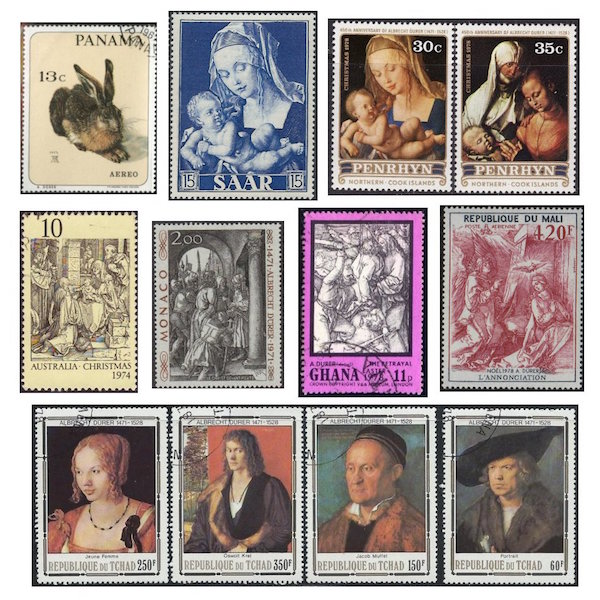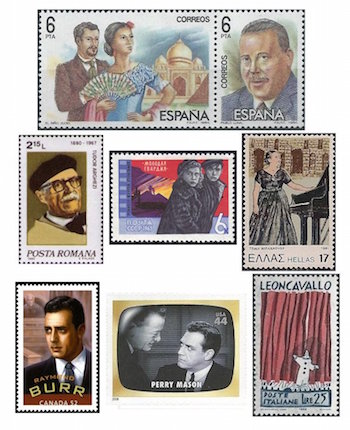The Arts on the Stamps of the World — May 21
An Arts Fuse regular feature: the arts on stamps of the world.

By Doug Briscoe
Another Old Master, another plethora of stamps devoted to his work. Albrecht Dürer (21 May 1471 – 6 April 1528) may be more represented philatelically than any other artist we’ve seen here so far, or at least it seems that way to me. The oldest Dürer stamp, I think, is the famous Christlike self-portrait shown on a German design of 1926 (upper left). It and the one next to it, from 1961, come from sets of definitive, not commemorative stamps, but the rest of our offerings today all fall into the latter category. (To recap, “definitives” are stamps issued for daily use without “commemorating” a particular subject. US flag stamps are an example.) Another German stamp, showing a detail from the well-known engraving of the bagpipe player (1514), is succeeded by another self-portrait (1493) on a French issue of 1980. That first self-portrait, nowadays distinguished as Self-Portrait at 28, (1500), is seen in full color on one of the stamps from a set issued by the Congo (PR). I don’t propose to identify every individual art work here, but I’ll draw your attention to the famous pen-and-ink Praying Hands (c. 1508) in the third row and Young Hare (1502) at the beginning of the second collage. A sampling of Dürer’s magnificent woodcuts on stamps of Australia, Monaco, Ghana, and Mali follows before we conclude with an array of portraits (of people other than himself) as seen on a set from Chad. We’ve filled two pages with Dürer stamps, and there are dozens and dozens more.


Another much-loved painter, but one from a very different milieu, is next. Henri Rousseau was also born on May 21st, but in the year 1844. One of his most-recognized paintings, The Sleeping Gypsy (La Bohémienne endormie, 1897) serves as our centerpiece. It’s a minisheet from the Maldive Islands (not shown to scale). At its edges we see (clockwise from upper left), The Snake Charmer (1907), which was commissioned by Robert Delaunay‘s mother, Exotic Landscape (1908), Father Juniet’s Gig (1908), La guerre (1894), The Football Players (1908), and Self Portrait (1890). Rousseau was in the main self-taught and did not fully devote himself to the art until he was in his forties. His primitivist style, only partly ingenuous, was ridiculed by some critics, but he was admired by such figures as Picasso, Juan Gris, Brâncuși, and the poet Guillaume Apollinaire, who wrote Rousseau’s epitaph. Rousseau died as the result of a blood clot on September 2, 1910.

Spanish composer Pablo Luna (1879 – January 28, 1942) wrote more than sixty zarzuelas, the most famous being El niño Judío (The Jewish Boy, 1918), and a further two dozen operettas and other stage works. He also wrote eleven screenplays using the pseudonym García Sandoval.
Tudor Arghezi was the pseudonym of Romanian poet Ion N. Theodorescu (21 May 1880 – 14 July 1967), who first published his work when he was only 16. He spent four years in a monastery and started his own magazine in 1904, though it soon folded. Arghezi was in Switzerland during the Romanian Peasants’ Revolt of 1907, with which he strongly sympathized, though he didn’t return to Romania until 1910. He became an art critic and in these years produced much verse and many articles, many of them polemical. Romanian territorial questions led him to side with the Central Powers during World War I, for which he was arrested and incarcerated, and against the Axis Powers in World War II, when he was arrested and imprisoned again. He had an up-and-down relationship with the succeeding Communist government; at one point the attacks against him were so virulent that he had to earn his living by selling the cherries that grew in his yard. Then the powers that be decided he was OK after all, and he was showered with honors. His approach is now seen as a reinvigoration of the Romanian language and a reinvisioning of traditional literary structure and genres. He began to write children’s stories, for which he would become well known, in the early 1930s.
Soviet director and screenwriter Sergei Gerasimov (21 May 1906 – 26 November 1985) began acting in films in 1924. He had prominent roles in The New Babylon (1929) and Alone (1931). (Shostakovich composed the scores for both films.) He first directed in 1936 and went on to make films for nearly fifty years. Two of his most highly regarded films are The Young Guard (1948, the subject of the 1965 Soviet stamp) and his adaptation with Mikhail Sholokhov of the latter’s celebrated novel And Quiet Flows the Don (1958). For his last film, Leo Tolstoy (1984), he not only directed but played the title role. The world’s oldest film school, Moscow’s VGIK, founded in 1919, was renamed for Gerasimov in 1986. (VGIK, if you must know, stands for Vsesoyuzniy Gosudarstvenniy Institut Kinematografii—All-Union State Institute of Cinematography.)
The fine pianist Gina Bachauer (1913 – August 22, 1976) was born and died in Athens. She gave 630 concerts for Allied troops in the Middle East during World War II. She died in 1976 of a heart attack on the day she was to appear as soloist. The Gina Bachauer International Piano Competition was established the same year.

Maybe I should have led this piece off with Raymond Burr, because he was born one hundred years ago today (May 21, 1917). The embodiment of Perry Mason, Burr originally auditioned for the role of prosecuting attorney Hamilton Burger. He was born in British Columbia and came to the U.S. at the age of six. Always struggling with obesity, he got plenty of work in radio. As for the movies, “I was just a fat heavy,” he said. “I split the heavy parts with Bill Conrad.” He slimmed down (temporarily) for the role that he made an icon in American popular culture—271 episodes and 26 TV movies. He died on September 12, 1993.
Pagliacci had its première on this date in 1892 at the Teatro Dal Verme in Milan. The conductor was Arturo Toscanini. I present the same 1958 Italian Leoncavallo stamp we saw on his birthday (April 23).
Oh, insupportable affront! That the great, great Alexander Pope (21 May 1688 – 30 May 1744) should have no stamp! Well, blessed is the man who expects nothing, for he shall never be disappointed. And I presume the poet turneth not in his grave, because, after all, to err is human, to forgive divine. Fats Waller (May 21, 1904 – December 15, 1943) deserves a stamp, too. In 2012, the USPS issued a block of ten stamps honoring American poets, but Robert Creeley (May 21, 1926 – March 30, 2005) was not one of them.
Many, many happy returns of the day to the Good Fight Keeper-Upper, Al Franken (born May 21, 1951); long may he legislate!
A graduate of the University of Massachusetts with a B.A. in English, Doug Briscoe worked in Boston classical music radio, at WCRB, WGBH, and WBUR, for about 25 years, beginning in 1977. He has the curious distinction of having succeeded Robert J. Lurtsema twice, first as host of WGBH’s weekday morning classical music program in 1993, then as host of the weekend program when Robert J.’s health failed in 2000. Doug also wrote liner notes for several of the late Gunther Schuller’s GM Recordings releases as well as program notes for the Boston Classical Orchestra. For the past few years he’s been posting a Facebook “blog” of classical music on stamps of the world, which has now been expanded to encompass all the arts for The Arts Fuse.
